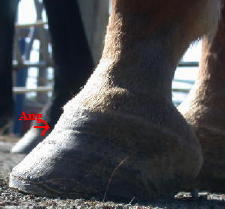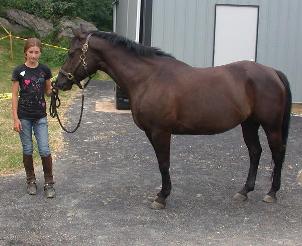Healthy laminae are vital in preventing founder. The health of the laminae is determined in part by their length. The shorter they are, the more tightly they connect the coffin bone to the inside of the hoof wall, because they are not ‘stretched out’. Their distance is measured horizontally from the coffin bone to the inside of the hoof wall. On the sole view, they appear as a narrow, tight, healthy white line with no separation.
The photos in this progression essentially speak for themselves, and are used to illustrate the change in the laminar connection, as well as the angle of growth, once a correct trim is undertaken. Equally obvious results are evident in horses that are already barefoot but were not correctly trimmed, and examples of these will be posted in future entries. (Reader contributions as always are welcome).
 August
August
The horse was ‘rescued’ from a hack line by a new owner at this point. The horse was bruising himself with the shoes due to the overgrown feet.
 September
September
One month after the shoes were removed, the horse has largely self-trimmed its feet to this profile with the exception of the toe being rasped a little by hand. The new laminar growth has come in so much tighter (closer to the coffin bone) that the hoof wall has ‘separated’ away at the line of new growth and looks like a crack. The second half of the new growth has come in at a more correct angle as the hoof started correcting itself.
 October
October
The new growth has progressed almost halfway down the hoof and continues to come in at a steeper angle, closer and tighter to the coffin bone.
 November
November
A small amount of old growth remains, projecting beyond the new growth.
 December
December
The growth is now all at the same angle and the ‘cracked’ hoof wall has almost grown out.
The pastern angle remains steep as a result of joint adaptation (from the long term incorrect hoof form visible in August), rather than heel pain.


































